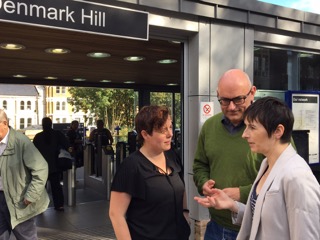Our most notorious road junction in East Dulwich is where East Dulwich Grove (EDG) meets Lordship Lane. It feels dangerous and you have be razor sharp crossing with confidence. Over the last 5 years 10 crashes have occurred.
Putting full traffic lights would significantly reduce the capacity of Lordship Lane there and result in lots more rat running. It would also see significant parking removed to make it happen – both along Lordship Lane and East Dulwich Grove – which is predicted to speed traffic up countering any safety.
On a site visit with council officials we noted the following potential improvements:
1. Tactile pavement indicated where to cross is set back along EDG away from the sightlines of cars turing from Lordsihp lane in EDG. Propose move this towards Lordship Lane.
2. Move the Bell Bollard so it actually protects pedestrians.
3. Why was the coloured raised treatment replaced with black tarmac. REnew in different colour to inidcate a pedestrian crossing.
4. Place anti skid surface to allow better braking.
5. Resurface Lordship Lane.
6. Place hatching on whole junction after resurfacing
It was agreed at the site meeting and post meeting review that drivers could be mentally or cogniticely overloaded with so many different visual ques. To reduce this we could:
1. Remove yellow hatching,
2. Mark the correct turning circle, as they do on some roundabouts, to reduce incidence of drivers cutting the corner.
Further thoughts:
1. What would it cost to raise the whole junction up to slow all vehicles?
2. Could we install average speed cameras around this junction to ensure no speeding?
What do you think – how can we make this junction safe?


